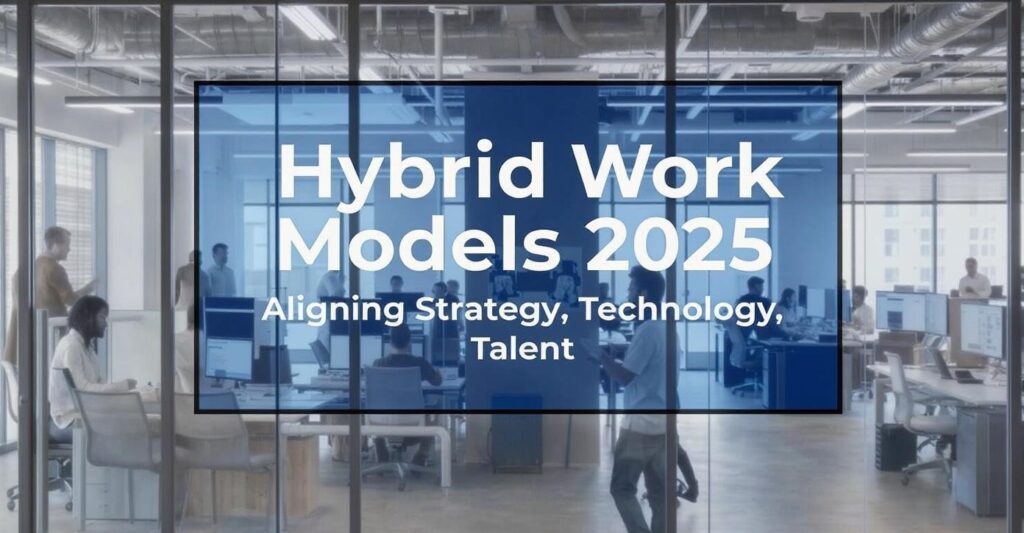The business landscape has been permanently altered by the hybrid work revolution. As we head into 2025, the evolution of workplace models continues to prioritize adaptability, employee well-being, and streamlined digital collaboration. For forward-thinking companies, understanding the intricacies of hybrid work models in 2025 is no longer a competitive advantage—it’s a necessity.
Understanding the Shift Toward Hybrid Work Models 2025
Hybrid work models in 2025 are no longer an experiment—they’re a mature, strategically optimized approach to workforce management. These models combine remote and on-site work in varying ratios, depending on the industry, role, and company culture.
With technological infrastructure growing more robust, employers can now offer flexibility without compromising on productivity. Artificial intelligence (AI), cloud computing, and cybersecurity are the backbone of this transformation, enabling smooth transitions between home and office environments.
Key Drivers of Hybrid Work Models 2025
Several key factors have accelerated the adoption of hybrid work models in 2025:
Employee expectations for flexibility: A majority of the workforce, especially Gen Z and Millennials, prefer roles that allow them the flexibility to work from home or alternate locations.
Cost optimization: Businesses are reducing overhead costs related to office space and utilities by embracing hybrid setups.
Technological maturity: Seamless communication, project management, and collaboration tools have eliminated the productivity gap between remote and in-office work.
Focus on talent acquisition and retention: Companies offering hybrid work options are better positioned to attract top-tier global talent.
Best Practices for Implementing Hybrid Work Models in 2025
To achieve optimal flexibility and productivity in hybrid environments, companies must embrace tested best practices tailored to modern needs.
Design Workflows Around Flexibility, Not Just Location
Instead of simply designating days for remote or office work, leading companies in 2025 design their workflows around flexibility. Employees are empowered to decide where they work based on the task at hand.
For instance, brainstorming sessions may require in-office presence, while deep-focus work might be better performed remotely. By focusing on the nature of the task rather than the physical space, businesses foster greater productivity.
Utilize Smart Scheduling and Resource Management
AI-driven scheduling tools are a core component of hybrid work models in 2025. These systems can automate team rosters, book shared workspaces, and optimize employee schedules based on productivity trends.
Resource management tools also track utilization of office space, conference rooms, and digital platforms. Businesses can ensure fair access to shared assets and prevent scheduling conflicts.
Standardize Communication Across All Channels
The success of hybrid work models depends heavily on communication clarity. To maintain productivity and inclusion, communication must be standardized across all channels.
This means defining:
Preferred platforms (e.g., Microsoft Teams, Slack, Zoom)
Expected response times
Meeting etiquette and structure
Communication hierarchies
Such clarity avoids silos between remote and in-office employees, improving overall operational flow.
Focus on Cybersecurity and Data Protection
With employees working across multiple devices and networks, hybrid work models in 2025 demand airtight cybersecurity. Cyber threats are becoming more sophisticated, and businesses must invest in secure access protocols, zero-trust architectures, and endpoint protection.
Key strategies include:
Multi-factor authentication (MFA) for all devices
Regular cybersecurity training for employees
Encrypted collaboration platforms
AI-driven anomaly detection to spot security breaches
This ensures that flexibility does not come at the cost of data integrity or customer trust.
Leverage Performance Analytics and AI Insights
Data is the engine driving productivity improvements in hybrid work models. In 2025, advanced AI and analytics tools help monitor performance, identify inefficiencies, and customize employee support.
Managers no longer rely on outdated metrics like time at desk. Instead, they evaluate:
Output quality
Collaboration effectiveness
Skill development progress
Client satisfaction
These metrics offer a more accurate and humane measure of productivity, aligning employee success with organizational goals.
Prioritize Employee Well-being and Inclusion
Hybrid work models in 2025 go beyond convenience—they also foster holistic employee experiences. Businesses that integrate wellness programs into the hybrid framework see higher engagement and lower turnover.
Important initiatives include:
Virtual wellness sessions and counseling access
Regular team-building activities for remote and in-office staff
Mental health check-ins as part of manager 1:1s
Ergonomic stipends for home offices
A strong focus on well-being creates a culture of trust and care—essential components of hybrid work success.
Redesign Physical Office Spaces for Hybrid Compatibility
The physical office is no longer a mandatory place of work—it’s a hub for collaboration. In 2025, companies are redesigning offices to suit hybrid purposes, with less emphasis on fixed desks and more on flexible, shared spaces.
Best practices include:
Hot-desking areas with digital reservation systems
Collaboration zones with AV setups for hybrid meetings
Quiet pods for solo tasks during in-office days
Wellness and recharge zones
Such configurations foster meaningful on-site engagement when employees choose to come in.
Empower Leadership to Adapt and Guide Change
Strong leadership is essential to the success of hybrid work models in 2025. Managers need to be equipped with the tools and mindset to lead distributed teams effectively.
This involves training in:
Remote team management
Digital communication best practices
Emotional intelligence and inclusion
Change management and resilience
Leaders who model transparency and flexibility will inspire confidence in hybrid teams.
Ensure Legal Compliance and Clear Policy Documentation
Hybrid work, by nature, introduces complexities related to labor laws, taxation, and regulatory compliance—especially for global teams. Businesses must clearly document hybrid policies, including:
Remote work eligibility
Work hours and overtime rules
Equipment and expense reimbursements
Jurisdictional employment laws
By consulting legal experts and maintaining clear internal documentation, businesses mitigate risk while supporting employee flexibility.
Encourage Cross-Functional Collaboration
In hybrid setups, it’s easy for departments to become isolated. To maintain a collaborative culture, businesses in 2025 are investing in cross-functional initiatives such as:
Cross-team innovation challenges
Shared knowledge repositories
Inter-departmental stand-ups and updates
Rotational mentorship programs
This helps bridge physical gaps and drives business-wide innovation.
Hybrid Work Models 2025: An Opportunity for Business Excellence
Hybrid work models in 2025 represent more than a flexible work arrangement—they are an operational blueprint for resilient, innovative, and people-first organizations. From reimagining office design to adopting AI-powered tools, these models help businesses unlock agility while preserving culture and performance.
Adopting the best practices outlined above will ensure that hybrid work isn’t just sustainable—it becomes a long-term strategic asset for productivity, growth, and talent engagement.
Read Full Article : https://bizinfopro.com/blogs/hr-blogs/hybrid-work-models-2025-best-practices-for-flexibility-and-productivity/
About Us : BizInfoPro is a modern business publication designed to inform, inspire, and empower decision-makers, entrepreneurs, and forward-thinking professionals. With a focus on practical insights and in‑depth analysis, it explores the evolving landscape of global business—covering emerging markets, industry innovations, strategic growth opportunities, and actionable content that supports smarter decision‑making.



